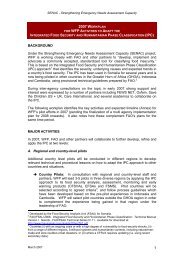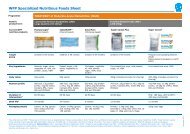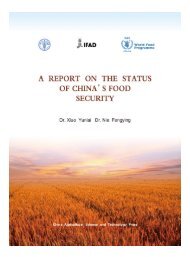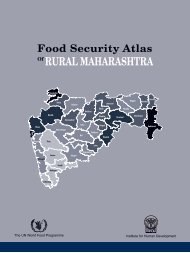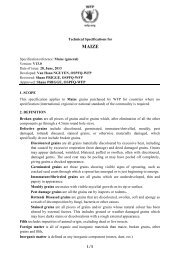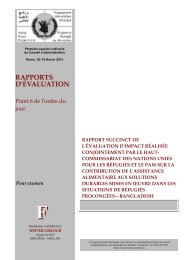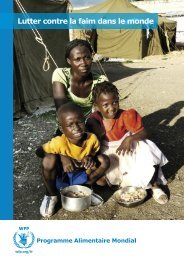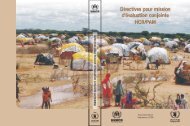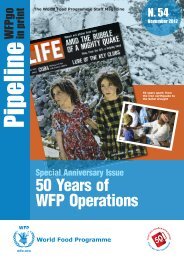High Food Price Impact Assessment and Analysis - WFP Remote ...
High Food Price Impact Assessment and Analysis - WFP Remote ...
High Food Price Impact Assessment and Analysis - WFP Remote ...
Create successful ePaper yourself
Turn your PDF publications into a flip-book with our unique Google optimized e-Paper software.
• Extreme variety in the availability of information from one context to another.<br />
• The inevitable difficulty in reconciling the approaches of the different disciplines that need to<br />
collaborate to fully underst<strong>and</strong> the impact of the current economic situation: economics; nutrition;<br />
sociology; anthropology, etc.<br />
• The complexity <strong>and</strong> scope of the situation, <strong>and</strong> so of information required to fully underst<strong>and</strong> the<br />
current problem (<strong>and</strong> opportunities). In the current context, participants identified greatly enhanced<br />
requirements for information on, inter alia: types of food consumed; non-food expenditures; regional /<br />
cross border food flows <strong>and</strong> trade; Differences in urban/rural livelihoods <strong>and</strong> food prices <strong>and</strong><br />
relationships between urban <strong>and</strong> rural markets. While many of the analyses which were presented at<br />
the workshop were addressing some of these areas, very few could look at them all.<br />
Recommendations:<br />
1) A tiered approach is necessary with: i) an early warning mechanism, based on a small number of indicators that<br />
enable monitoring household food security, ii) rapid assessments, <strong>and</strong> more in-depth analyses when time <strong>and</strong><br />
resource permit.<br />
2) Identify <strong>and</strong> agree on a small number of key indicators for use in an early warning system.<br />
Key Issue #3: Analytical methods: how to establish the link between prices <strong>and</strong> households?<br />
Situation: Different methods exist <strong>and</strong> have different implications. Hypothesis for the global analysis <strong>and</strong><br />
estimates conducted are often not clear <strong>and</strong> need to be tested. At country level, several methods are used<br />
such as the FAO modelling <strong>and</strong> simulation, the food security monitoring tools <strong>and</strong> other methods such as<br />
primary data analysis tools. Often the impact of higher food prices is not necessarily measurable.<br />
Recommendations:<br />
1) Global risk or vulnerability analysis needs to be validated <strong>and</strong> should be informed by country level<br />
analysis.<br />
2) Country level methods need validation to verify the modelled impacts;<br />
3) Outcome indicators (such as nutrition <strong>and</strong> dietary diversity <strong>and</strong> frequency) should be looked at for<br />
validation;<br />
4) There is a need to better use qualitative information to underst<strong>and</strong> the likely impacts of the food price<br />
increases.<br />
Questions raised <strong>and</strong> points made: The hypotheses are not yet validated. There is a need to further<br />
elaborate <strong>and</strong> test them. It was noted that it is difficult to build up a conceptual framework to assess the<br />
impact of high food prices, as this phenomena is difficult to isolate from other causes of food insecurity.<br />
This is particularly difficult in urban areas.<br />
Key issue #4: Compatibility <strong>and</strong> integration of secondary data<br />
Situation: there is a proliferation of information available. However the challenge is the discrepancy of<br />
data sets at national levels. Data is rarely compatible <strong>and</strong> comparable. It is often a challenge to establish<br />
links between all surveys <strong>and</strong> analysis done. The willingness to share data is often missing. This is an<br />
institutional problem.<br />
Recommendations:<br />
1) National sampling frameworks need to be developed.<br />
2) Partners should coordinate the timing of assessments to facilitate comparisons.<br />
3) Publications <strong>and</strong> reports should clearly document the process, the methology <strong>and</strong> constraints.<br />
4) Previous surveys should be updated <strong>and</strong> modified when administrative boundaries change to facilitate<br />
comparison over time.<br />
5) Partners should seek to collect data together.<br />
6) Data sharing between organisations should be encouraged.<br />
8



